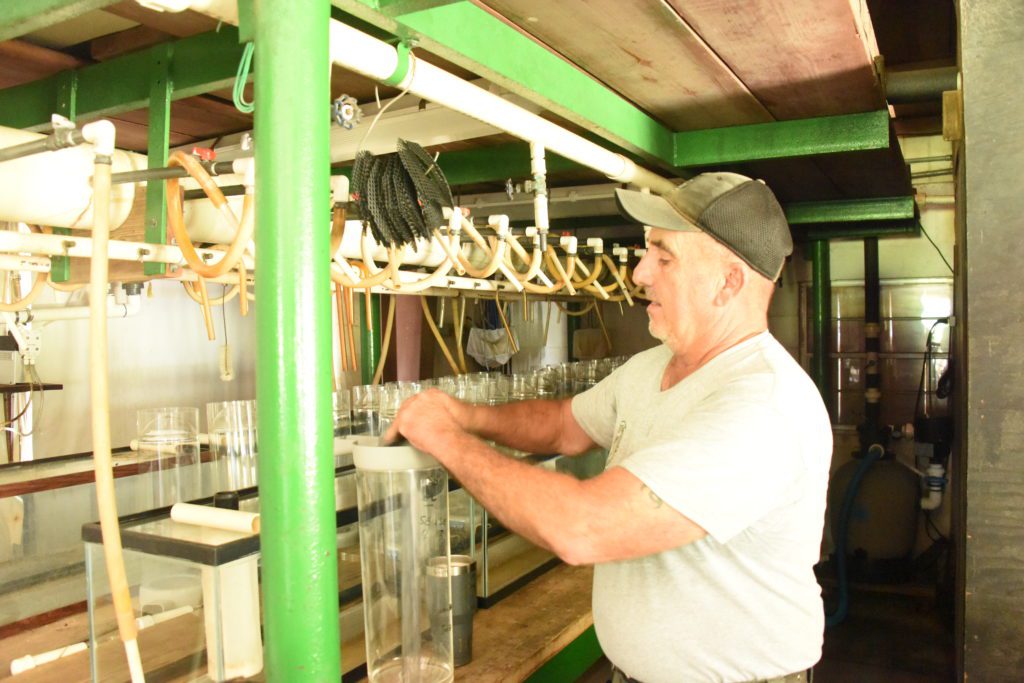Spawning success saves Shoal bass
Tucked away in rural Santa Rosa County within the Blackwater River Forest sits an operation that has been critical to recovery efforts of the Chipola River Shoal Bass population.
In existence for 80 years, the nearly 600-acre Blackwater Fisheries Research and Development Center in Holt has been at the center of helping to revive a species of fish that was devastated by Hurricane Michael in October of 2018.

A total of 3,300 hatchery-spawned fingerlings released into the Chipola River in May were the end result of an effort to help restock that species in the river.
“It’s very rewarding,” said Bob DeMauro, the manager of the hatchery. “It’s a big deal for all of us.”
Chris Paxton, the regional fisheries administrator for the FWC, agrees and hopes it’s a sign of good things to come for the species.
“We are hopeful that this will be a positive step toward the Shoal Bass population recovery in the Chipola River population.”
The Chipola River Shoal Bass are a priority and were actually inching toward becoming one even before the Category 5 hurricane made landfall in Panama City in 2018.
“It was identified as something we needed to look at even before the hurricane,” DeMauro said. “In 2017, the FWC made it a priority because of its limited range and because it’s susceptible to habitat and environmental factors.”

But the hurricane ramped up the priority level, leaving widespread damage of the floodplain. Paxton said the river rose 12 feet above normal and the flow of the river went from 850 cubic feet per second to 6,700 cubic feet per second.
Paxton knew it was bad.
“FWC fisheries biologists were able to assess the population in the Chipola River following the hurricane, so we knew the detrimental impact the storm had taken on it,” Paxton said.
A survey in 2019 within a six-and-a-half-mile conservation area in the river for the bass found only 33 fish compared to 361 in 2017. Then last fall another survey was done and 196 fish were found, but that was a drastic drop compared to the 951 found in 2009.
“The results further supported our concern and need for a management effort to conserve the shoal bass population in Florida.”
And that’s where the hatchery in Blackwater came into play. In 2019, an attempt was made to spawn fish at the hatchery.
“It went from let’s learn what we need to do to make it happen to we really need to do this,” DeMauro said.
Spawning riverine species of fish in a hatchery, however, is no easy task. The environment is decidedly different in a pond than it is in a river.

But fish were collected in 2019 and brought to the hatchery. They were kept in tanks where light and temperature could be controlled. That following spring they were released into a pond.
“They didn’t spawn, but two things happened within a week of putting them in there. It got hot and the water temperatures jumped. It’s a big reason why they didn’t spawn.”
A second effort was made in 2021. The results were the same. It was back to the drawing board, only this time some changes were made before going forward with a third attempt.
“It took time to figure things out. Shoal bass are a temperamental type of fish. We figured out that handling them just prior to spawning may actually stress them out,” DeMauro said.
So, this time, the bass were released into the pond in November of last year, giving them a chance to adapt and be exposed to varied conditions.
“We ended up producing 3,400. We took 100 to genetically test and the other 3,300 were stocked in the Chipola River May 10. It was our first successful attempt.”
The hatchery in Holt is one of only two in the state run by the FWC, and between the two hatcheries, 3 million to 5 million fish are stocked in lakes and rivers each year.
Shoal Bass are one of four species of native black bass sportfish in Florida, and it is potentially the genetically purest population remaining within its native range, according to Paxton.
It’s why the fact that the hatchery has been successful in aiding the recovery of the species is such a big deal.
It takes trial and error, but it’s worth it.
“We hoped the first year was a success, but when we weren’t, was it disappointing? Yes.
But we learned from what happened and made tweaks. We kept going until we figured it out,” DeMauro said.
Expectations are high moving forward, with the hope being to return the population to at least its pre-storm level.
“One of the benchmarks that will be needed to consider this restoration effort successful will be to restore Shoal Bass population numbers to what they were before the effects of Hurricane Michael,” Paxton said.
DeMauro is hopeful.
“This is an ongoing effort, and the hope is to preserve the population. It’s a population only in Florida, so it’s kind of a big deal. We don’t want to lose it,” DeMauro said. “It’s a big deal we were successful, and the thing now is we want to repeat it.”




